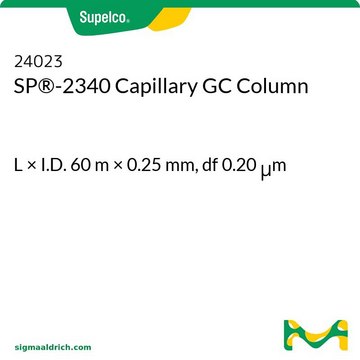25319
Colonne capillaire pour la GC SP®-2380
L × I.D. 30 m × 0.53 mm, df 0.20 μm
About This Item
Produits recommandés
Matériaux
fused silica
Agence
meets requirements for USP G48
Paramètres
≤25-275 °C temperature (isothermal or programmed)
Valeur bêta
663
df
0.20 μm
Technique(s)
gas chromatography (GC): suitable
L × D.I.
30 m × 0.53 mm
Groupe de la matrice active
Stabilized; poly(90% biscyanopropyl/10% cyanopropylphenyl siloxane) phase
Application(s)
agriculture
chemicals and industrial polymers
clinical
food and beverages
Type de colonne
capillary highly polar
Vous recherchez des produits similaires ? Visite Guide de comparaison des produits
Description générale
Code USP : Cette colonne répond aux exigences de l′USP G48.
Phase :
- Stabilisée
- Polysiloxane (90 % biscyanopropyl/10 % cyanopropylphényl)
- De sub-ambiante à 275 °C (isotherme ou programmée)
Application
- SP®-2380 Capillary Column may be used for determination of fatty acid composition in crude oil in capillary gas chromatography, used along with normal and reverse-phase high-performance liquid chromatography (HPLC) in order to study the content and composition of tocopherols, sterols, and phospholipids in soybean oils derived from genetically-modified soybeans.
- It was found suitable to be used for the identification of fatty acid methyl esters from mammalian samples by fast gas chromatography.
- It was suitable for determining the hydrogenation level and the level of isomerisation development during the hydrogenation process of edible oils by capillary gas chromatography.
- It was also suitable to be used in gas chromatography equipped with flame ionization detector (FID) for analysing the cytotoxicity of fatty acids from seed oils containing conjugated linolenic acids (CLN) on mouse tumor and human monocytic leukemia cells.
Autres remarques
Informations légales
Faites votre choix parmi les versions les plus récentes :
Déjà en possession de ce produit ?
Retrouvez la documentation relative aux produits que vous avez récemment achetés dans la Bibliothèque de documents.
Notre équipe de scientifiques dispose d'une expérience dans tous les secteurs de la recherche, notamment en sciences de la vie, science des matériaux, synthèse chimique, chromatographie, analyse et dans de nombreux autres domaines..
Contacter notre Service technique


